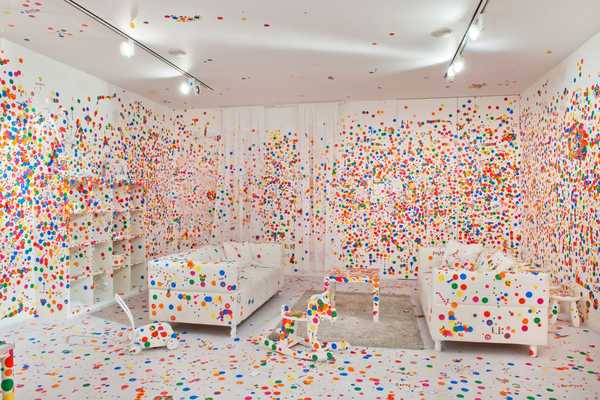

In Grand Orgy to Awaken the Dead (1969), Kusama painted dots on participants’ naked bodies in an unauthorized performance in the fountain of the sculpture garden of New York’s Museum of Modern Art. Those Happenings often involved public nudity, with the stated intention of disassembling boundaries of identity, sexuality, and the body. Mirroring the times, Kusama’s performance art explored antiwar, antiestablishment, and free-love ideas. Mirrors gave her the opportunity to create infinite planes in her installations, and she would continue to use them in later pieces. Installations from that time included Infinity Mirror Room-Phalli’s Field (1965), a mirrored room whose floors were covered with hundreds of stuffed phalli that had been painted with red dots. 1 (1962), with small soft phallic sculptures constructed from white fabric. The theme of sexual anxiety linked much of that work, in which Kusama covered the surface of objects, such as an armchair in Accumulation No. Obsessive repetition continued to be a theme in Kusama’s sculpture and installation art, which she began to exhibit in the early 1960s. She became a central figure in the New York avant-garde, and her work was exhibited alongside that of such artists as Donald Judd, Claes Oldenburg, and Andy Warhol. Her paintings from that period anticipated the emerging Minimalist movement, but her work soon transitioned to Pop art and performance art. Such works explored the physical and psychological boundaries of painting, with the seemingly endless repetition of the marks creating an almost hypnotic sensation for both the viewer and the artist.

Those consisted of thousands of tiny marks obsessively repeated across large canvases without regard for the edges of the canvas, as if they continued into infinity. Her early work in New York City included what she called “infinity net” paintings. Before leaving Japan, she destroyed many of her early paintings.Ĭan You Match These Lesser-Known Paintings to Their Artists? Family conflict and the desire to become an artist drove her to move in 1957 to the United States, where she settled in New York City. She had little formal training, studying art only briefly (1948–49) at the Kyōto City Specialist School of Arts. Those hallucinations and the theme of dots would continue to inform her art throughout her career.

She employed painting, sculpture, performance art, and installations in a variety of styles, including Pop art and Minimalism.īy her own account, Kusama began painting as a child, at about the time she began experiencing hallucinations that often involved fields of dots. Yayoi Kusama, (born March 22, 1929, Matsumoto, Japan), Japanese artist who was a self-described “obsessional artist,” known for her extensive use of polka dots and for her infinity installations. Although she had relationships with fellow artists, she never married or had children. She indicated that her mother was physically and verbally abusive, while her father was a womanizer. Yayoi Kusama was born the youngest daughter of an affluent family.

Saving Earth Britannica Presents Earth’s To-Do List for the 21st Century.Britannica Beyond We’ve created a new place where questions are at the center of learning.100 Women Britannica celebrates the centennial of the Nineteenth Amendment, highlighting suffragists and history-making politicians.
OBLITERATION ROOM HOW TO


 0 kommentar(er)
0 kommentar(er)
